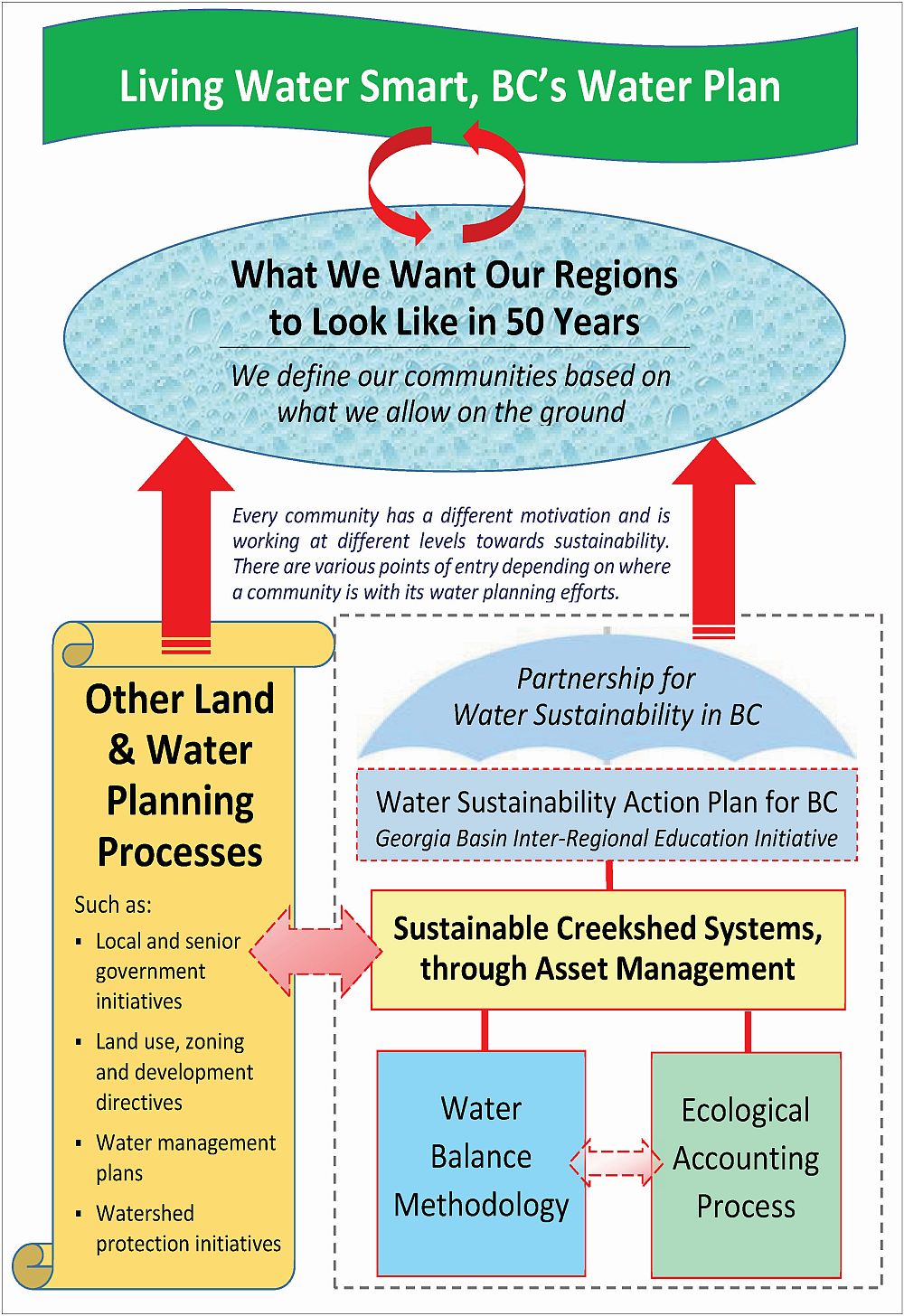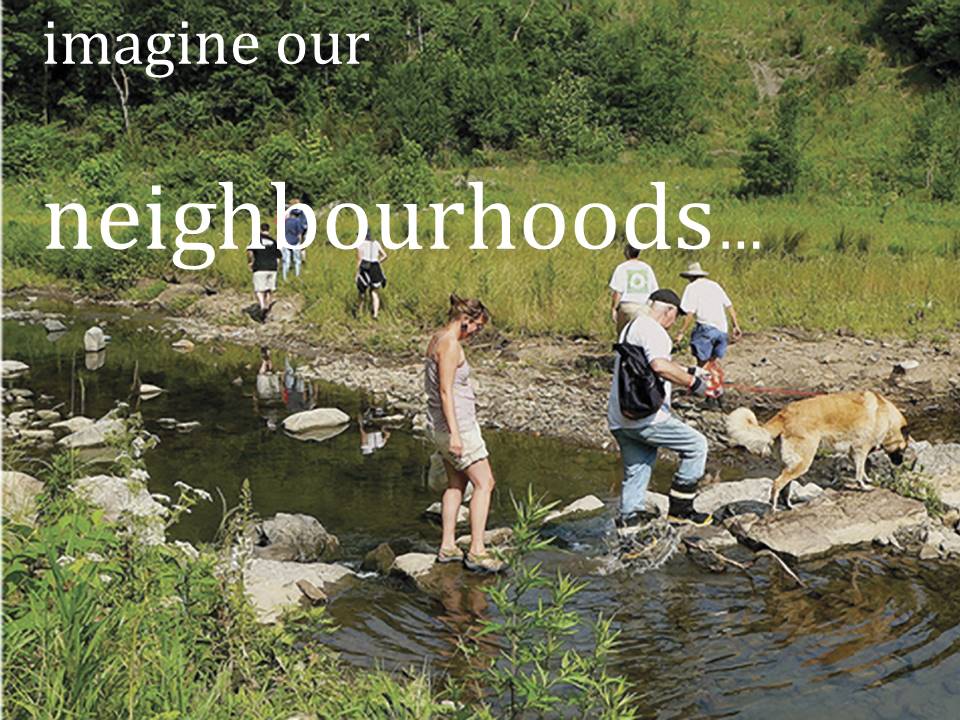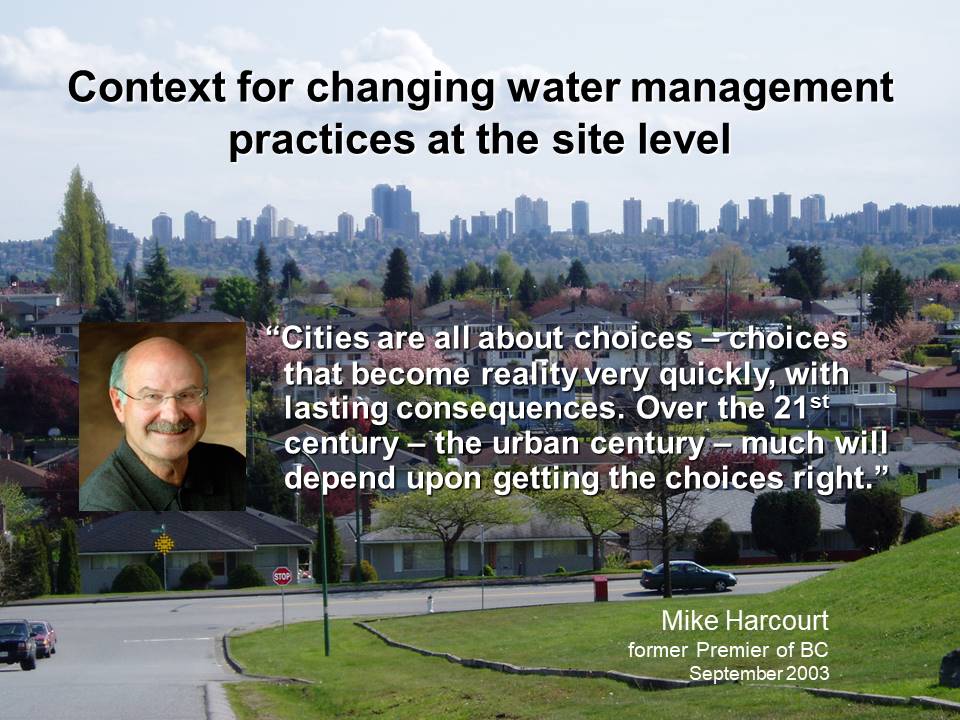WATER SUSTAINABILITY ACTION PLAN: The Partnership’s Water-Centric Planning community-of-interest provides a legacy record for preserving stories about “Living Water Smart, British Columbia’s Water Plan” and adapting to a changing climate
NOTE TO READER:
Released in February 2004, the Water Sustainability Action Plan for British Columbia is guided by the vision for Living Water Smart, British Columbia’s Water Plan, and the set of actions identified therein for influencing behaviour, building greener communities and adapting to a changing climate.
The Action Plan introduced a framework for building partnerships and demonstrating what can be achieved through a ‘top-down & bottom-up strategy’ that aligns efforts at the provincial, regional and local scales to respond and adapt to a changing world. Water-Centric Planning is one of six elements originally comprising the Action Plan. It established a guiding philosophy for integrating missions, mandates and accountabilities to plan with a view to water.
 “Following release of Living Water Smart in 2008, the government of British Columbia maintained livingwatersmart.ca as a stand-alone portal to support the Living Water Smart program. On the BC Ministry of Environment website (in 2020), Living Water Smart is now just a dropdown under the topic area “Water Planning and Strategies”. This reflects the fact that Living Water Smart way-of-thinking is fully integrated into the business as usual,” states Kim Stephens, Executive Director, Partnership for Water Sustainability in British Columbia.
“Following release of Living Water Smart in 2008, the government of British Columbia maintained livingwatersmart.ca as a stand-alone portal to support the Living Water Smart program. On the BC Ministry of Environment website (in 2020), Living Water Smart is now just a dropdown under the topic area “Water Planning and Strategies”. This reflects the fact that Living Water Smart way-of-thinking is fully integrated into the business as usual,” states Kim Stephens, Executive Director, Partnership for Water Sustainability in British Columbia.
“The provincial government allowed its ownership of the URL to lapse in 2017 when the aforementioned change was made. This development underscored the legacy importance of this Water-Centric Planning community-of-interest as the online home for preserving the Living Water Smart historical record, or least as it is viewed through the Partnership lens in our role as the outreach arm of Living Water Smart.”
The cascading relationship between Living Water Smart and the Action Plan is illustrated by the graphic below.

What We Want Our Regions to Look Like in 50 Years
“The goal is to build greener communities,” continues Kim Stephens. “To achieve this goal, three objectives associated with Living Water Smart are:
- Deal with Uncertainty
- Manage the Water Balance
- Adapt to a Changing Climate
“A desired outcome is that economy, ecology and human settlement will be in balance. This phrase encapsulates the essence of what water-centric planning is striving to accomplish.”

Expectations for Living Water Smart
“Living Water Smart is an idea that people are embracing. The solutions and commitments go beyond what government does,” stated Lynn Kriwoken on page 58 of Beyond the Guidebook 2010: Implementing a New Culture for Urban Watershed Protection and Restoration in British Columbia, wherein she provided her perspective on the cascading relationship between Living Water Smart and the Water Sustainability Action Plan. An Executive Director in the Ministry of Environment, Lynn Kriwoken led the Living Water Smart initiative from its inception until her retirement from government in 2020.
 “Living Water Smart is a plan that is as much about land as water – because only with healthy water can we enjoy all the values that we take for granted. Times are changing and the way we do business is also changing.
“Living Water Smart is a plan that is as much about land as water – because only with healthy water can we enjoy all the values that we take for granted. Times are changing and the way we do business is also changing.
“By choosing to live water smart, communities will be more prepared for climate change and their quality of life will be enhanced. If we can show how to get the water part right, then other parts are more likely to follow.
“The partnership umbrella provided by the Water Sustainability Action Plan has allowed the Province to leverage partnerships to greatly enhance the profile and resulting impact of Living Water Smart. In effect, the Action Plan partners are functioning as the on-the-ground Living Water Smart implementation arm with local government. The in-kind support from local governments is substantial and growing, and means my team can focus our work effort on legislative reform.”
To Learn More:
Living Water Smart comprises 45 commitments, which are grouped into five themes (see below). The Action Plan has played a key delivery role in two of the five theme areas, namely: community planning and development (#5); and efficiency, outreach, public awareness (#2).
Download a copy of Beyond the Guidebook 2010: Implementing a New Culture for Urban Watershed Protection and Restoration in British Columbia.

Build the Vision, Create the Legacy
“The ultimate goal of the Living Water Smart and Green Communities initiatives is to establish expectations that, in turn, will influence the form and function of the built environment. If land and water practitioners are then successful in bringing a water for life and livelihoods vision to fruition by embracing shared responsibility, this will create a legacy for those who follow in our footsteps,” continued Lynn Kriwoken.
“Living Water Smart is about adaptation – that is, collectively what we need to do, to adapt, to prepare for climate change. How we will get there is all about collaboration – that’s my code for silo jumping. We must get out of our silos and broaden our perspectives. Learn from others, share with others – that is when we grow.”

Living Water Smart
B.C.’s water is essential to our quality of life. The impacts of climate change, our growing population and a vibrant economy mean that we need a different approach to water management.
Living Water Smart provides the B.C. Government’s vision for sustainable water stewardship and sets the direction for changes to water management and water use. These changes are crucial for adapting to climate change impacts and the pressures placed on water resources from a growing population and economy.
Living Water Smart is a provincial plan and delivery involves eleven ministries and a range of stakeholders. The Ministry of Environment is responsible for overall coordination and reporting on Living Water Smart and is also leading action on a number of specific commitments in the plan.
Local and federal governments, industry groups, First Nations, non-governmental organizations, communities and citizens all have important roles to play in achieving water stewardship and play a vital role in achieving the Living Water Smart vision and goals.
Implementing Living Water Smart is well underway with the Water Sustainability Act, which came into effect on February 29, 2016. Other activities include
- Keeping water in mind when we develop our communities, protecting sources of drinking water and strengthening flood protection to adapt to climate change.
- Ensuring wetlands and waterways will be protected and rehabilitated and land activities will not negatively impact our water.
- Modernizing B.C.’s Water Laws to ensure adequate stream flows, ecosystem health, more community involvement, and protection of groundwater.
- Setting strong water efficiency targets and working with all sectors to reduce water consumption.
- Improving science and information so British Columbians can better prepare for the impacts of climate change.
It will take a collective effort to make this vision a reality. We must all work together to protect water sources, manage water demands, modernize water systems and infrastructure, and live water smart.
To Learn More:
Click on Modernizing B.C.’s water laws and the Water Sustainability Act.



